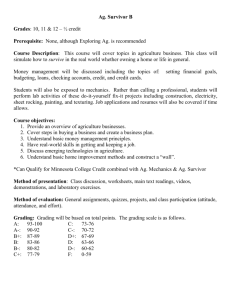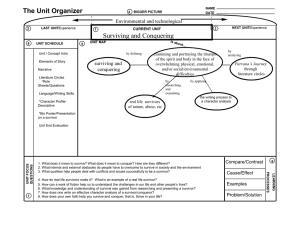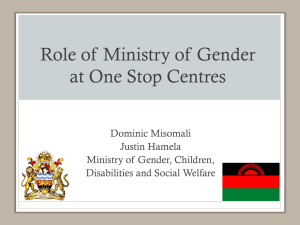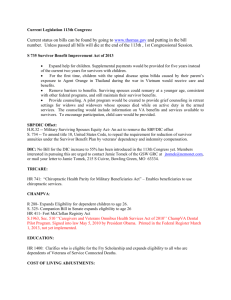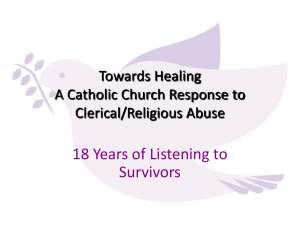PowerPoint on Confidentiality
advertisement
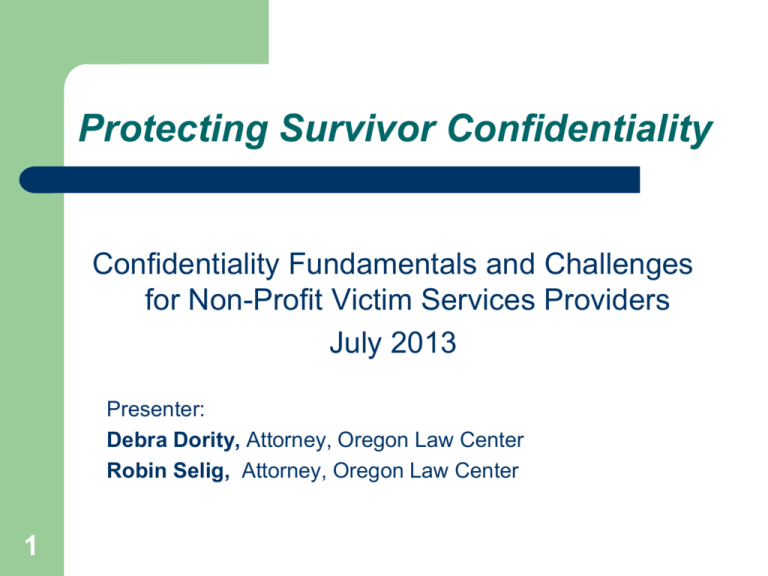
Protecting Survivor Confidentiality Confidentiality Fundamentals and Challenges for Non-Profit Victim Services Providers July 2013 Presenter: Debra Dority, Attorney, Oregon Law Center Robin Selig, Attorney, Oregon Law Center 1 Topics Covered 2 Confidentiality and Privilege VAWA 2013 Confidentiality Provisions Releases of Information Mandatory Child Abuse Reporting Subpoena Response Record Keeping Working with Community Partners Why Is Confidentiality Important? Fundamental principle at core of victim services. When assured of confidentiality: 3 Survivors will be less afraid of being humiliated, blamed, or rejected by friends, family, and community, and more willing to access services. Survivors will disclose the true nature of abuse or assault to allow effective safety planning and responses. Survivors’ trust in advocacy services will be reinforced. Why Is Confidentiality Important? cont’d. Enhances survivor safety. Preserves the dignity of survivors and empowers survivors. 4 Disclosure can cause escalation of violence, reveal the safe location of a survivor and her children, and compromise her safety plan. Reinforces principle that survivors control their personal information. Survivors decide if, how, and when it will be shared. Why Is Confidentiality Important? cont’d. What happens when survivors lose control of their information? It might: 5 Be used against survivor in divorce, custody, and child welfare cases, or manipulated by perpetrators in criminal cases. Affect a survivor’s employment, education, or housing. Affect a survivor’s health and/or re-traumatize the survivor. Affect a survivor’s relationships with family, friends, and the community. When You Stand Up for Survivors, Who Is Standing Up With You? 6 Funding requirements are a recognition by public policy makers of the importance of confidentiality of survivors. You have the support of… Who Else Stands With You? Oregon does! ORS 409.273(2)(b) ORS 409.292 7 All information maintained by the sexual assault crisis center or crisis line relating to clients is confidential. All information maintained by the shelter home, safe house, or crisis line relating to clients is confidential. Confidential Communication v. Statutorily Privileged Communication 8 Definition of terms. Oregon law. What Is a Confidential Communication? A COMMUNICATION: Made with the expectation of privacy. Not accessible to the general public. No legal requirement that recipient keep information private. 9 What Is Statutory Privilege? A confidential COMMUNICATION: Created by statute. Disclosure is prohibited without permission. Protected from disclosure in court or other proceedings. Some exceptions apply (e.g. mandatory child abuse reporting). May be “waived” by holder of the privilege. 10 Examples of Statutory Privileges 11 Husband – Wife Attorney – Client Priest – Penitent Psychotherapist – Patient Doctor – Patient Common theme: one should be able to speak freely to certain individuals without fear of repercussions. What Is Advocate Privilege? This term is used to describe a statutory privilege that protects the communications between: victims of domestic violence, sexual assault, or stalking And advocates at non-governmental domestic violence or sexual assault programs. 12 Does Oregon Have Advocate Privilege? Oregon currently has no statutory privilege to protect survivor communications with advocates in nonprofit programs. 13 Does not affect fundamental commitment of programs to maintain client confidentiality. Principles of safety and respect compel us all to protect confidentiality to the greatest extent possible. Various funding streams require strict confidentiality. Whether or Not There Is a Statutory Privilege, Principles of Privilege are Relevant to Oregon Non-Profit Programs: Commitment to safety of and respect for survivors compel us to protect confidentiality to the greatest extent possible. Applying principles of privilege: 14 Enhances client safety and quality of services. Increases program credibility when resisting subpoenas. Basic Rule 15 Decision to share or not to share is survivor’s choice. An advocate cannot release/share information without the informed consent of the survivor. VAWA 2013 16 Incorporates “Basic Rule.” Confidentiality is a grant condition. Grantees and subgrantees are required to protect the confidentiality and privacy of persons receiving services. VAWA 2013 - Nondisclosure 17 Grantees may not disclose, reveal or release personally identifying information or individual information in connection with services requested, utilized, or denied through grantees’ and subgrantees’ programs, regardless of whether the information has been encoded, encrypted, hashed or otherwise protected. VAWA 2013 - When Is Disclosure Allowed? VAWA allows release of information in only 3 circumstances: 1. With the informed, written, reasonably timelimited consent of the person (special rules if person is minor or legally incapacitated with guardian). 2. 18 3. Remember WITS: written, informed, time-limited, survivor centered. Statutory mandate. Court mandate. VAWA 2013 - Releases of Information 19 Grantees may not disclose, reveal, or release individual client information without the informed, written, reasonably time-limited consent of the person (or in the case of an unemancipated minor, the minor and the parent or guardian or in the case of legal incapacity, a court-appointed guardian) about whom information is sought whether for this program or any other Federal, State, tribal or territorial grant program. VAWA 2013 - Releases of Information, cont’d. 20 Except that consent for release may not be given by the abuser of the minor, incapacitated person, or the abuser of the other parent of the minor. If a minor or person with a legally appointed guardian is permitted by law to receive services without the parent’s or guardian’s consent, the minor or person with a guardian may release information without additional consent. What About Verbal Releases? Inconsistent with VAWA grant condition. Risky and not recommended. Not best practice. May be able to justify in order to serve immediate, urgent need of a survivor. 21 Get written consent ASAP. Verify identity of caller if on the phone. What If There Is a True Emergency? 22 Provide emergency operator and responders only enough information to respond. Do so without giving out personally identifying information. Less is best. What Is Reasonably Time Limited? 23 Reasonable time frame given needs of survivor and purpose of release. 15 to 30 days ideal but can be longer. Balance inconvenience of signing new release with protecting survivor. What Is Informed Consent? 24 The knowing and informed decision to waive privilege/confidentiality and disclose information. The survivor MUST understand the alternatives to and risks and benefits of disclosure. ROI Forms Forms should contain: Description of the information to be released, name of the agency designated to receive the information, purpose, duration, and date. Statement acknowledging that the survivor has: 25 read the form, been informed of the alternatives to and risks and benefits of disclosure, and understands consequences of authorizing the release of information to 3rd parties. Statement informing survivor that ROI is revocable. 26 VAWA – Consent to Release Cannot Be a Condition of Eligibility In no circumstances may: 27 An adult, youth or child victim of domestic violence, dating violence, sexual assault or stalking be required to provide a consent to release his or her personally identifying information as a condition of eligibility for the services provided by the grantee or subgrantee. New and explicit in VAWA 2013. Scenario #1 A DHS caseworker calls for a copy of your case file. The caseworker says he had the survivor sign a release for her file and wants you to fax a copy of the file to his secured fax machine ASAP. You know that the file indicates that the participant was asked to leave shelter due to violent behavior. 28 How do you respond to the caseworker? Would you respond any differently if the information in the file was not negative? Scenario #2 You receive a call from a survivor’s divorce attorney asking you to make a copy of your case file and mail it to her in its entirety. The survivor previously signed a release for you to talk to the attorney, but that was before she left shelter. You have not spoken with the survivor for several weeks. 29 How do you respond to the divorce attorney? VAWA 2013 - When Release Is Compelled by Statutory or Court Mandate If compelled by statutory or court mandate, grantees must: 30 Make reasonable attempts to notify survivor and Take steps necessary to protect the privacy and safety of the persons affected by the release of information. VAWA 2013 - What Does Compelled by Statutory Mandate Mean? When a statute (law) requires an act by an individual or entity. 31 Mandatory child abuse reporting is one example. Mandatory reporting of elder abuse is another. VAWA 2013 – Compelled by Statutory Mandate, cont’d. 32 Query: does VAWA allow an advocate who is not a mandatory child abuse reporter to make a report of child abuse? Child Abuse Reporting What is mandatory child abuse reporting? 33 Refers to law that requires certain “public or private officials” to report child abuse. ORS 419B.005 to 419B.050. Crux of Law at ORS 419B.010(1) 34 “Any public or private official having reasonable cause to believe that any child with whom the official comes in contact has suffered abuse or that any person with whom the official comes in contact has abused a child shall immediately report or cause a report to be made…” What Does Public or Private Official Mean? Law defines this term and some examples are: 35 Physicians, including any intern or resident, dentist, school employee, licensed practical nurse or registered nurse, psychologist, member of the clergy, licensed clinical social worker, attorney, licensed professional counselor, firefighter or emergency medical technician, employee of DHS. Narrow Exceptions: 36 Psychiatrist, clergy, attorney or guardian ad litem is not required to report if the communication is covered by a statutory privilege. What Does Abuse Mean? 37 Spelled out in statute at ORS 419B.005(1). Definition includes ten separate categories. Ranges from assault, rape, and sexual abuse to negligent treatment endangering the health and welfare of a child. May differ from common understanding or individual ideas of what constitutes child abuse. Are Advocates in Non-Profit Victim Services Programs Mandatory Reporters? No, unless they are also a public or private official. 38 For example, a licensed clinical social worker working as a advocate in a shelter. Remember Our Query… 39 Does VAWA allow an advocate who is not a mandatory child abuse reporter to make a report of child abuse? Impact of VAWA 2013 on Child Abuse Reporting Practices 40 VAWA does not prohibit a grantee from reporting suspected abuse or neglect, as those terms are defined and specifically mandated by the State or tribe involved. This means that VAWA 2013 does prohibit an advocate, who is not a mandatory child abuse reporter, from reporting child abuse unless the survivor signs a release of information premised on informed consent. Program Responsibilities 41 To understand the difference between mandatory child abuse reporting and “voluntary” child abuse reporting. To disclose your reporting obligations (if any) to the survivor BEFORE the survivor makes disclosures. To know who among your staff and volunteers is a mandatory reporter. Program directors and boards with attorney assistance should review current policies on child abuse reporting to take into account VAWA 2013. Scenario #3 A junior high school student comes into your organization and begins to tell you about a party she was at where she believes her drink was compromised and she was drugged. She became very dizzy all of the sudden and is not sure what happened, but she woke up several hours later naked and sore. 42 Assume you are not a mandatory reporter and your agency receives VAWA funding. What do you do? Assume you are a mandatory reporter, would you approach this situation any differently? When You Have Concerns About the Safety of a Survivor’s Child - 43 Speak with your immediate supervisor or Executive Director. Consider working with the survivor to make a voluntary report. Remember, a program cannot require a survivor to sign a release of information as a condition of receiving services. For More Information About Child Abuse Reporting in Oregon 44 See booklet called: What you can do about child abuse @ http://dhsforms.hr.state.or.us/Forms/Served/ DE9061.pdf VAWA 2013 - What Does Compelled by Court Mandate Mean? A court mandate is a judicial command, order or precept, written or oral, from a court. Are subpoenas court mandates? 45 Answer: unclear. Best Practice: assume subpoenas are not court mandates; obtain legal advice and take legal steps to resist subpoena and/or obtain protective orders. Do not simply ignore the subpoena! What Is A Subpoena? 46 A subpoena is an order that requires a person to appear and provide testimony. A subpoena duces tecum is an order that requires the production of records or documents. Subpoena Response Policy Practical Tips: 47 Never disclose anything to the person serving (delivering) the subpoena. Note how subpoena was served, by whom, and when it was received (date/time). Note whether it is accompanied by a check for appearance fee and mileage. Inform the executive director and “custodian of the records” immediately. Call an attorney for immediate assistance. NOTE: subpoena response must be timely! What Does VAWA 2013 Require In Terms of Subpoena Response? 48 In every case, notice to survivor and taking steps to protect privacy and safety of survivor and other affected by the release is required. Best practice: Motion to Quash and Motion for Protective Order. Remember WITS – determine if survivor consents to disclosure. Scenario #4 You are in criminal court with a survivor. The defense attorney comes over and asks to speak with you separately. You go down the hall and she serves you with a subpoena duces tecum. The defense attorney then asks you how long you have been working with the victim, and when she can pick up a copy of your file. 49 How do you respond to the defense attorney? What do you do about the subpoena? VAWA 2013 – What Information Can Be Shared? Grantees may share: 50 Non personally identifying data in the aggregate regarding services to their clients and Non personally identifying demographic information in order to comply with federal, state, tribal or territorial reporting, evaluation, or data collection requirements. VAWA 2013 – What Information Can Be Shared? Grantees also may share: 51 Court-generated information and law enforcement generated information contained in secure, government registries for protection order enforcement purposes and Law enforcement- and prosecution-generated information necessary for law enforcement and prosecution purposes. Other Funding Streams 52 DOJ/CVSD and DHS policy decision to have uniform confidentiality provisions across funding streams. Text of confidentiality requirements in VOCA, ODSVS, DHS contracts same as in VAWA contracts. Family Violence and Prevention Services Fund has now adopted VAWA confidentiality provisions. What Steps Can Victim Services Providers Take to Protect Survivor Confidentiality? 53 Develop and adhere to clearly written confidentiality policies and protocols. Why Are Written Policies and Protocols Important? 54 Best protect survivor confidentiality and safety. Emphasize agency commitment to confidentiality. Ensure that staff, volunteers, and clients all have the same information/understanding. Ensure consistency of agency practice. Decrease likelihood of inadvertent release of information. Enhances the ability of programs to seek court protection of survivor information. Explaining Confidentiality to Survivors 55 Survivors should be provided with clear, easy to understand information about program confidentiality policies and protocols BEFORE they are asked to make disclosures. Such explanations should include a discussion of any exceptions to confidentiality. What Are Best Practices Re: Record Keeping Policies? Develop a program policy to keep minimal survivor records. Identify custodian of records. Limit access to survivor files. Consider keeping survivor files locked. 56 Record Keeping, cont’d. Records should include: Records should not include: 57 Only what is necessary to the delivery of services. Non-personally identifying information required by funders. Casual comments, verbatim statements made by or concerning a survivor (including emails, letters), opinions, criticisms, observations or speculations, information from other sources or information unrelated to providing services. Photos. Anything that would compromise survivor safety if released. Why Worry About Records? 58 There is always the risk that records could be successfully subpoenaed. Programs must balance the need for documentation with the potential risk to survivor if information is disclosed. Working With Community Partners 59 Know your community partners and their policies regarding confidentiality of survivor information. Provide partners with information about your confidentiality policies and funding restrictions. Important to understand respective roles, range of services and strengths. Respect and mutual understanding is key. What Can You Do About Challenges Around Confidentiality? 60 Discuss confidentiality issues at outset. Develop written policies or MOUs around confidentiality policies for the collaboration. Consider structures for ongoing communication and problem-solving. Clarify that role is not information-sharing. When it becomes a struggle, remember who is standing with you: Role of Advocates Participating in Co-location or Other Collaborations Nonprofit victims services programs need not provide personal information when: 61 Providing general information about intimate partner violence dynamics. Identifying gaps in services. Offering support services and safety planning. Giving perspective on survivor experiences. Suggesting ways agency partners can increase survivor safety. More Pointers to Enhance Collaboration Help partners understand necessity of proper releases of information. understand problematic nature of subpoenas: 62 Undermine survivors’ trust in nonprofit victims services provider and Negatively impact nonprofit victim services providers’ ability to serve the community. Scenario #5 63 You are working with a survivor whose abuser was recently arrested for domestic violence. The survivor has returned to her abuser on several occasions after such an assault. You are attending a multi-disciplinary meeting. The district attorney, probation officer and police officer involved in the arrest of your client’s abuser are discussing the case. They are mentioning facts that you know are not true and, if they knew the real facts, it would help your client. They are also saying that the survivor is just going to return to the abuser anyway “just like last time.” What, if anything, can you do or say? What Are the Benefits of Effective Collaboration? Effective collaboration leads to: 64 More effective referrals. Appropriate division of labor. Survivors receiving a broad spectrum of services. Resources OCADSV Manual - frequently asked legal Qs. National Network to End Domestic Violence: Funded by the Office of Violence Against Women to provide technical assistance to recipients of VAWA funding. Helpful online resources. 65 Information on technology safety planning. Templates for confidentiality policies. Caution: Materials may not have been updated for VAWA 2013. Acknowledgements This presentation is based on materials developed by: 66 Sybil Hebb and Robin Selig, Oregon Law Center Jessica Mindlin, Victim Rights Law Center Oregon Coalition Against Domestic and Sexual Violence Kim Larson, Director, Marion County District Attorney’s Office, Victim Assistance Division Presenters: Debra Dority ddority@oregonlawcenter.org 503-640-4115 Robin Selig rselig@oregonlawcenter.org 503-473-8323. 67 Final Note 68 Please feel free to distribute copies of this presentation for general educational use. The information is up-to-date as of June 2013. It is not intended as a substitute for the advice of an attorney. Please do not revise, adapt or amend the content of this document without the written permission of the Oregon Law Center. Thank You! 69 For your work to help end domestic and sexual violence.
